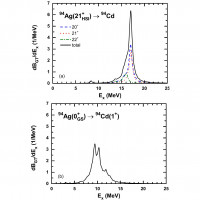Gamow-Teller transitions from high-spin isomers in $N=Z$ nuclei

Atomic nuclei are composed of protons and neutrons. We may imagine like a certain number of (quantum) balls putting in a (self-bound) container. On the one hand, the nuclear magic numbers show the single-particle features of nuclei; On the other hand, the giant resonances show the emergent collective features. For example, an intuitive image of giant dipole resonance is: All protons form a group while all neutrons form another group, and these two groups oscillate against to each other collectively.
Gamow-Teller resonance is an important kind of giant resonances involving not only the spin but also the isospin degrees of freedom in nuclei. So far, most, if not all, of experimental and theoretical studies on this direction focus on the resonances from the nuclei being in their ground states, largely due to the experimental limitations. However, it is expected that, in the near future, our world-leading nuclear facility in RIKEN can generate high-quality radioactive beams with nuclei being in their high-spin isomeric states. Motived by this perspective, we predict that the Gamow-Teller transitions from the high-spin isomers could be much more collective than the corresponding transitions from their ground states, by taking nuclei 52Fe and 94Ag as examples. This would be one of the promising collaborations between theorists and experimentalists in RIKEN.
- Reference
- H. Z. Liang, H. Sagawa, M. Sasano, T. Suzuki, M. Honma
"Gamow-Teller transitions from high-spin isomers in $N=Z$ nuclei"
Journal Reference: Phys. Rev. C 98, 014311 (2018)
doi: 10.1103/PhysRevC.98.014311
arXiv: 1801.09076
